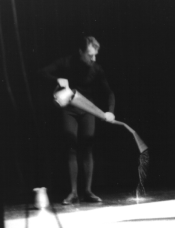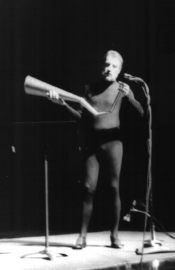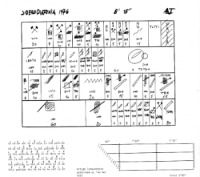Arrigo Lora-Totino
 Arrigo
Lora-Totino performing with a
Arrigo
Lora-Totino performing with a
ROTORMEGAFONO at the 11th International Sound
Poetry Festival, Toronto, 1978.
Photos by Larry Wendt.
Arrigo Lora-Totino has been active in visual poetry
since the sixties, and his research in that area
eventually led him to sound. He considered both areas as two sides of the same
literary impulse. He has published an extensive number of articles about the
aesthetic and history of experimental poetry, as well as performed his work on
radio, television and in many places in the world.
research in that area
eventually led him to sound. He considered both areas as two sides of the same
literary impulse. He has published an extensive number of articles about the
aesthetic and history of experimental poetry, as well as performed his work on
radio, television and in many places in the world.
Between 1960 and 1966, he founded and edited four issues of
antipiugiù, an experimental literature magazine with an emphasis
on concrete poetry. Lora-Totino also published the magazine Modulo, of
which the first issue (March 1966) was an international anthology of concrete
poetry. With Carlo Belloli, he founded the Museum of Contemporary Poetry in
Turin in the sixties.
Lora-Totino's poetry is concerned with the word as a visual
or sonic entity that amplifies the semantic concepts which it has come to
represent. In the sonic dimension he has experimented with all levels of
language from manipulating diction, to syntactical structure, to phonemic
construction: that point of contact between the ambiguous differences
existing between the minimal vocal vibrations which are not yet interpretable
and the articulation which are already significant. For the
production of his vocal work, he has made extensive use of both acoustic and
electronic methods of manipulation, and worked in an early electronic music
studio in Turin, Studio di Informazione Estetica.
For the
production of his vocal work, he has made extensive use of both acoustic and
electronic methods of manipulation, and worked in an early electronic music
studio in Turin, Studio di Informazione Estetica.
His performances were often wildly hilarious: part mime,
part Italian Futurist sintesi, part Commedia del 'Arte -- he
played the role of mischief maker. Many of these works include very short
phonetic pieces composed of Italian puns which require no translation to
communicate their joke, particularly since Lora-Totino, a rather tall,
distinguished looking Italian man with a neatly trimmed beard, often acts out
his poeisa ginnica (Athletic Poetry) while dressed in black tights. In
one recent piece in particular, he would strike a series of poses
(vogue) which would increase in complexity with a sound poem being
played from a recording. He also made use of his audience, 'training' small
groups of them to perform a particular work, such as handing out a collection
of peculiar bird whistles to an all-woman chorus and acting like their
love-sick conductor.
Lora-Totino also constructed a series of acoustical
horn-like devices for the performance of sound poetry, which are suggestive in
appearance to Luigi Russolo's intonorumori. One of these horns is known
as the ROTORMEGAFONO: it can project the voice in a rotating 360° circle
above the player's head. Another one is the IDROMEGAFONO which can filter vocal
sounds through water or oil. Another horn had a large glass jar in its base in
which he could place water for a reverberation effect or dry ice for an
'extremely tense sound.'

Last Modified 21 January 1998
 Arrigo
Lora-Totino performing with a
Arrigo
Lora-Totino performing with a  research in that area
eventually led him to sound. He considered both areas as two sides of the same
literary impulse. He has published an extensive number of articles about the
aesthetic and history of experimental poetry, as well as performed his work on
radio, television and in many places in the world.
research in that area
eventually led him to sound. He considered both areas as two sides of the same
literary impulse. He has published an extensive number of articles about the
aesthetic and history of experimental poetry, as well as performed his work on
radio, television and in many places in the world.